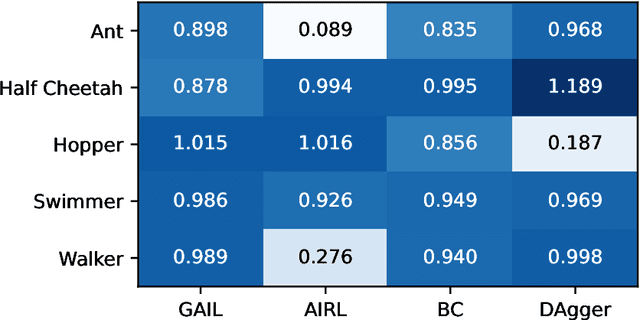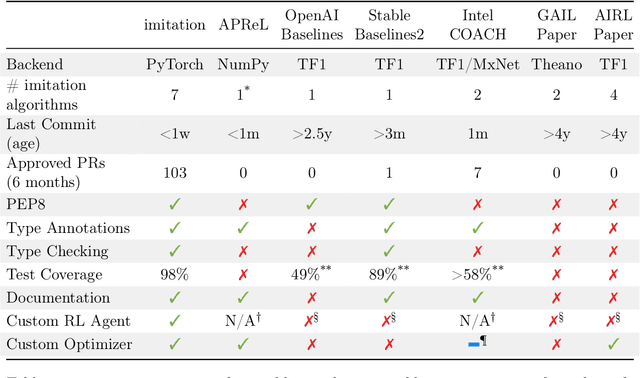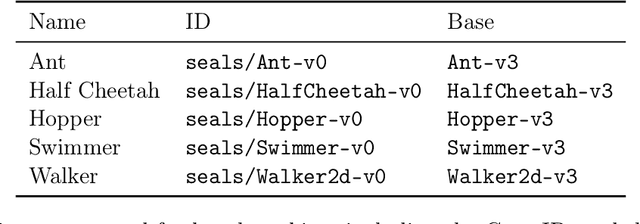Adam Gleave
Multi-Agent Risks from Advanced AI
Feb 19, 2025Abstract:The rapid development of advanced AI agents and the imminent deployment of many instances of these agents will give rise to multi-agent systems of unprecedented complexity. These systems pose novel and under-explored risks. In this report, we provide a structured taxonomy of these risks by identifying three key failure modes (miscoordination, conflict, and collusion) based on agents' incentives, as well as seven key risk factors (information asymmetries, network effects, selection pressures, destabilising dynamics, commitment problems, emergent agency, and multi-agent security) that can underpin them. We highlight several important instances of each risk, as well as promising directions to help mitigate them. By anchoring our analysis in a range of real-world examples and experimental evidence, we illustrate the distinct challenges posed by multi-agent systems and their implications for the safety, governance, and ethics of advanced AI.
Scaling Laws for Data Poisoning in LLMs
Aug 06, 2024Abstract:Recent work shows that LLMs are vulnerable to data poisoning, in which they are trained on partially corrupted or harmful data. Poisoned data is hard to detect, breaks guardrails, and leads to undesirable and harmful behavior. Given the intense efforts by leading labs to train and deploy increasingly larger and more capable LLMs, it is critical to ask if the risk of data poisoning will be naturally mitigated by scale, or if it is an increasing threat. We consider three threat models by which data poisoning can occur: malicious fine-tuning, imperfect data curation, and intentional data contamination. Our experiments evaluate the effects of data poisoning on 23 frontier LLMs ranging from 1.5-72 billion parameters on three datasets which speak to each of our threat models. We find that larger LLMs are increasingly vulnerable, learning harmful behavior -- including sleeper agent behavior -- significantly more quickly than smaller LLMs with even minimal data poisoning. These results underscore the need for robust safeguards against data poisoning in larger LLMs.
Exploring Scaling Trends in LLM Robustness
Jul 26, 2024



Abstract:Language model capabilities predictably improve from scaling a model's size and training data. Motivated by this, increasingly large language models have been trained, yielding an array of impressive capabilities. Yet these models are vulnerable to adversarial prompts, such as "jailbreaks" that hijack models to perform undesired behaviors, posing a significant risk of misuse. Prior work indicates that computer vision models become more robust with model and data scaling, raising the question: does language model robustness also improve with scale? We study this question empirically, finding that larger models respond substantially better to adversarial training, but there is little to no benefit from model scale in the absence of explicit defenses.
Planning behavior in a recurrent neural network that plays Sokoban
Jul 22, 2024Abstract:To predict how advanced neural networks generalize to novel situations, it is essential to understand how they reason. Guez et al. (2019, "An investigation of model-free planning") trained a recurrent neural network (RNN) to play Sokoban with model-free reinforcement learning. They found that adding extra computation steps to the start of episodes at test time improves the RNN's success rate. We further investigate this phenomenon, finding that it rapidly emerges early on in training and then slowly fades, but only for comparatively easier levels. The RNN also often takes redundant actions at episode starts, and these are reduced by adding extra computation steps. Our results suggest that the RNN learns to take time to think by `pacing', despite the per-step penalties, indicating that training incentivizes planning capabilities. The small size (1.29M parameters) and interesting behavior of this model make it an excellent model organism for mechanistic interpretability.
Can Go AIs be adversarially robust?
Jun 18, 2024Abstract:Prior work found that superhuman Go AIs like KataGo can be defeated by simple adversarial strategies. In this paper, we study if simple defenses can improve KataGo's worst-case performance. We test three natural defenses: adversarial training on hand-constructed positions, iterated adversarial training, and changing the network architecture. We find that some of these defenses are able to protect against previously discovered attacks. Unfortunately, we also find that none of these defenses are able to withstand adaptive attacks. In particular, we are able to train new adversaries that reliably defeat our defended agents by causing them to blunder in ways humans would not. Our results suggest that building robust AI systems is challenging even in narrow domains such as Go. For interactive examples of attacks and a link to our codebase, see https://goattack.far.ai.
Uncovering Latent Human Wellbeing in Language Model Embeddings
Feb 19, 2024



Abstract:Do language models implicitly learn a concept of human wellbeing? We explore this through the ETHICS Utilitarianism task, assessing if scaling enhances pretrained models' representations. Our initial finding reveals that, without any prompt engineering or finetuning, the leading principal component from OpenAI's text-embedding-ada-002 achieves 73.9% accuracy. This closely matches the 74.6% of BERT-large finetuned on the entire ETHICS dataset, suggesting pretraining conveys some understanding about human wellbeing. Next, we consider four language model families, observing how Utilitarianism accuracy varies with increased parameters. We find performance is nondecreasing with increased model size when using sufficient numbers of principal components.
Exploiting Novel GPT-4 APIs
Dec 21, 2023Abstract:Language model attacks typically assume one of two extreme threat models: full white-box access to model weights, or black-box access limited to a text generation API. However, real-world APIs are often more flexible than just text generation: these APIs expose ``gray-box'' access leading to new threat vectors. To explore this, we red-team three new functionalities exposed in the GPT-4 APIs: fine-tuning, function calling and knowledge retrieval. We find that fine-tuning a model on as few as 15 harmful examples or 100 benign examples can remove core safeguards from GPT-4, enabling a range of harmful outputs. Furthermore, we find that GPT-4 Assistants readily divulge the function call schema and can be made to execute arbitrary function calls. Finally, we find that knowledge retrieval can be hijacked by injecting instructions into retrieval documents. These vulnerabilities highlight that any additions to the functionality exposed by an API can create new vulnerabilities.
STARC: A General Framework For Quantifying Differences Between Reward Functions
Sep 26, 2023Abstract:In order to solve a task using reinforcement learning, it is necessary to first formalise the goal of that task as a reward function. However, for many real-world tasks, it is very difficult to manually specify a reward function that never incentivises undesirable behaviour. As a result, it is increasingly popular to use reward learning algorithms, which attempt to learn a reward function from data. However, the theoretical foundations of reward learning are not yet well-developed. In particular, it is typically not known when a given reward learning algorithm with high probability will learn a reward function that is safe to optimise. This means that reward learning algorithms generally must be evaluated empirically, which is expensive, and that their failure modes are difficult to predict in advance. One of the roadblocks to deriving better theoretical guarantees is the lack of good methods for quantifying the difference between reward functions. In this paper we provide a solution to this problem, in the form of a class of pseudometrics on the space of all reward functions that we call STARC (STAndardised Reward Comparison) metrics. We show that STARC metrics induce both an upper and a lower bound on worst-case regret, which implies that our metrics are tight, and that any metric with the same properties must be bilipschitz equivalent to ours. Moreover, we also identify a number of issues with reward metrics proposed by earlier works. Finally, we evaluate our metrics empirically, to demonstrate their practical efficacy. STARC metrics can be used to make both theoretical and empirical analysis of reward learning algorithms both easier and more principled.
On The Fragility of Learned Reward Functions
Jan 09, 2023Abstract:Reward functions are notoriously difficult to specify, especially for tasks with complex goals. Reward learning approaches attempt to infer reward functions from human feedback and preferences. Prior works on reward learning have mainly focused on the performance of policies trained alongside the reward function. This practice, however, may fail to detect learned rewards that are not capable of training new policies from scratch and thus do not capture the intended behavior. Our work focuses on demonstrating and studying the causes of these relearning failures in the domain of preference-based reward learning. We demonstrate with experiments in tabular and continuous control environments that the severity of relearning failures can be sensitive to changes in reward model design and the trajectory dataset composition. Based on our findings, we emphasize the need for more retraining-based evaluations in the literature.
imitation: Clean Imitation Learning Implementations
Nov 22, 2022



Abstract:imitation provides open-source implementations of imitation and reward learning algorithms in PyTorch. We include three inverse reinforcement learning (IRL) algorithms, three imitation learning algorithms and a preference comparison algorithm. The implementations have been benchmarked against previous results, and automated tests cover 98% of the code. Moreover, the algorithms are implemented in a modular fashion, making it simple to develop novel algorithms in the framework. Our source code, including documentation and examples, is available at https://github.com/HumanCompatibleAI/imitation
 Add to Chrome
Add to Chrome Add to Firefox
Add to Firefox Add to Edge
Add to Edge